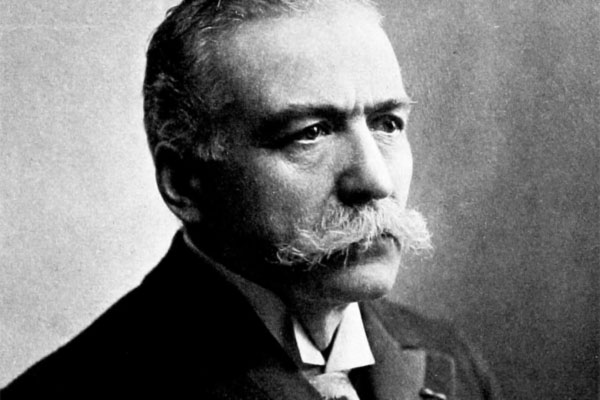
Novelty! It is the prevailing cry; it is imperiously demanded by everyone.
For all that, the number of alimentary substances is comparatively small, the number of their combinations is not infinite, and the amount of raw material placed either by art or by nature at the disposal of a cook does not grow in proportion to the whims of the public.
–Auguste Escoffier, Le Guide Culinaire
This month has seen a mini-trend in Grant Achatz reporting, preceding the opening of his new restaurant, Next: Christopher Borelli’s seven months of reporting came to fruition in a lengthy Tribune profile, which landed the same day as the New York Times‘s piece on the restaurant; Chicagoist’s Roger Kamholtz followed up with a DIY version of Aviary’s 2-in-one cocktail. So by now you’re probably aware of what’s to come:
The first menu is Paris 1906, a tribute to chef Auguste Escoffier, who simplified the preparation of haute cuisine and is considered the godfather of French gastronomy. Which, of course, is quite removed from the rotary evaporators and liquid nitrogen tanks at Alinea, where constant, radical invention is expected, where the kitchen is decorated with sketches of dishes he has imagined making one day and pockets of "pineapple leather" get filled with Chinese sausage.
What I hadn’t realized until I started poking around today was that Achatz tipped his hand a bit with an Atlantic blog post from 2009 (Next was announced in 2010), and before that, from Alinea’s first menu back in 2005: "Instead of featuring an updated, re-worked classic on Alinea’s opening menu, we included a dish executed verbatim from Escoffier’s Le Guide Culinaire: number 3970, "Fonds d’Artichauts Cussy," page 478." You can see a picture, #21, from an account of Alinea’s opening night.
In 2005, Achatz’s decision to use an Escoffier recipe was an "F-U," as he quotes himself as quoted by Michael Ruhlman. As he was theorizing Next, it’s clear his relationship to Le Guide Culinaire had deepened. Not just from his Atlantic post, but also from his account of visiting the legendary El Bulli as a 25-year-old, as described in his memoir Life, on the Line and excerpted in the New York Times:
My belief is that every 15 to 20 years, with an obvious bell curve of energy, most professions change. Technology, fine arts, design and yes, cooking, follow the same predictable pattern. A visionary creates the framework for a new genre, others follow and execute, and the residual effects remain, embedded in the cloth of the craft.
[snip]
Normally the evolution is gradual and seamless, and subtlety rules. Very rarely, a shift turns a profession upside down. The most notable and widely recognized example of this in cuisine is Auguste Escoffier. Nearly every chef cooking today knows who Escoffier is and respects how he changed the way generations after him cook. Culinary school textbooks are based on his works, and his cooking has been the foundation for every professional chef over the last century.
In drawing Next’s first menu from Le Guide Culinaire, Achatz is executing an elegant return–to a foundational moment in his industry, to a foundational aspect to his training and that of his peers, and to the first menu of Alinea as well.
As as if to complete the circle, Ecoffier’s rise was paralleled and aided by the birth of "gastronomic journalism"; the Michelin Guide, which awarded Achatz three stars and Charlie Trotter two in "as formal a passing of the culinary crown as it gets in Chicago," arose from the same cultural and culinary shift that produced, and was produced by, Escoffier.
We haven’t always been this fortunate in Chicago. In 1912, five years after Le Guide Culinaire was first translated into English, an anonymous writer for the Tribune set out to make Escoffier’s "les fraises Sarah Bernhardt," one of the many dishes Escoffier dedicated to celebrities. The writer was no less skeptical than Trotter was of Achatz in reflecting on a report from the "intelligent Esaus" (slang, it appears, for what we now think of as "foodies") at the Ligue des Gourmands:
There is some reference to Lucullus, inevitably, and the whole affair is a bit too ritualistic for a corn-fed generation, but getting out of the atmosphere of awe, no reason can be found why any family in possession of a freezer and a cream beater should not have a little mess of strawberries Sarah Bernhardt almost any time in strawberry season, and without paying five or six dollars for it.
[snip]
After you have tried it you may hasten back to old fashioned strawberry shortcake or to the strawberries and ice cream of the old fashioned lawn fete, but it might be worthwhile to try at least one flight into the higher raptures of the Ligue des Gourmands.
That’s the spirit, sort of. If you want to try your own flight into the higher raptures of Next–or if you fear, like me, that the crush of reservations will have you waiting until Achatz gets around to Hong Kong 2036–you can get a free digital copy of Le Guide Culinaire here.
Photo: Le Guide Culinaire, 1907


